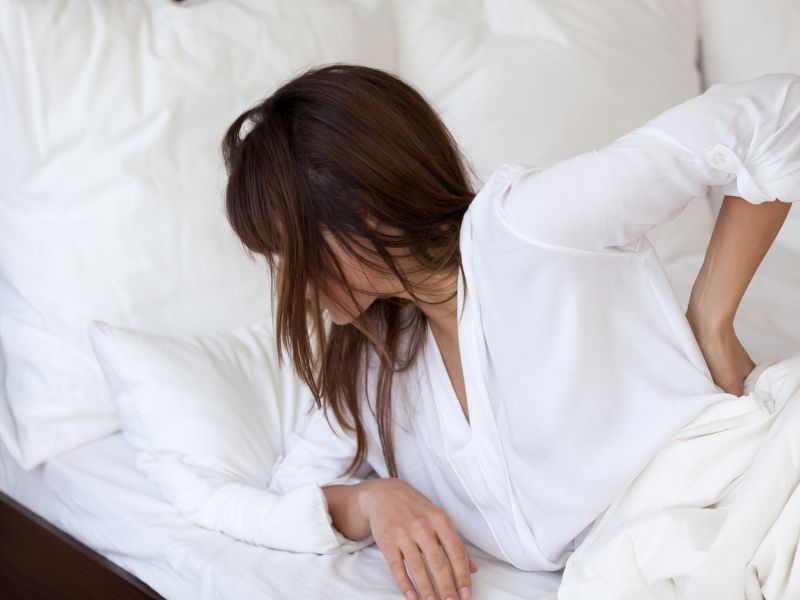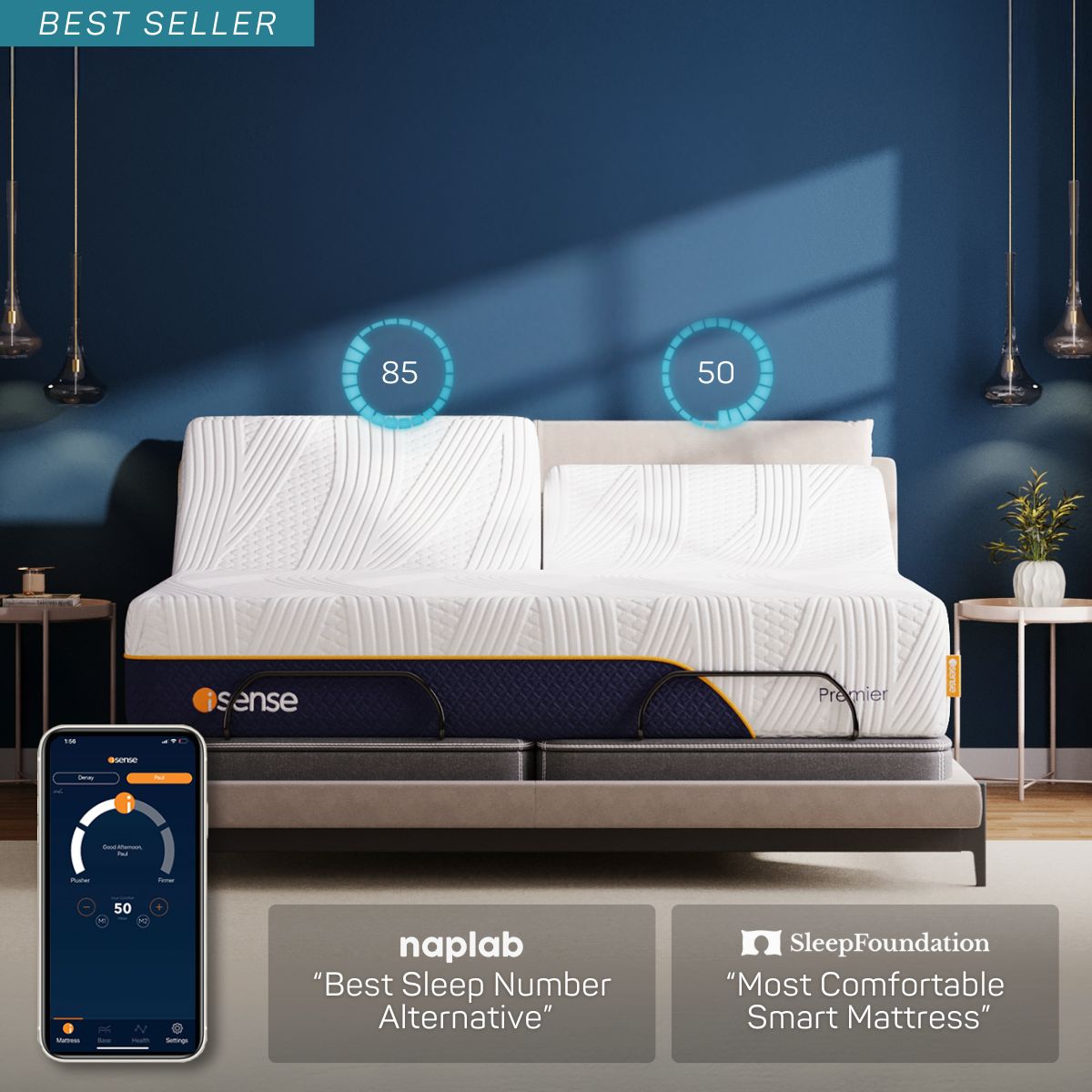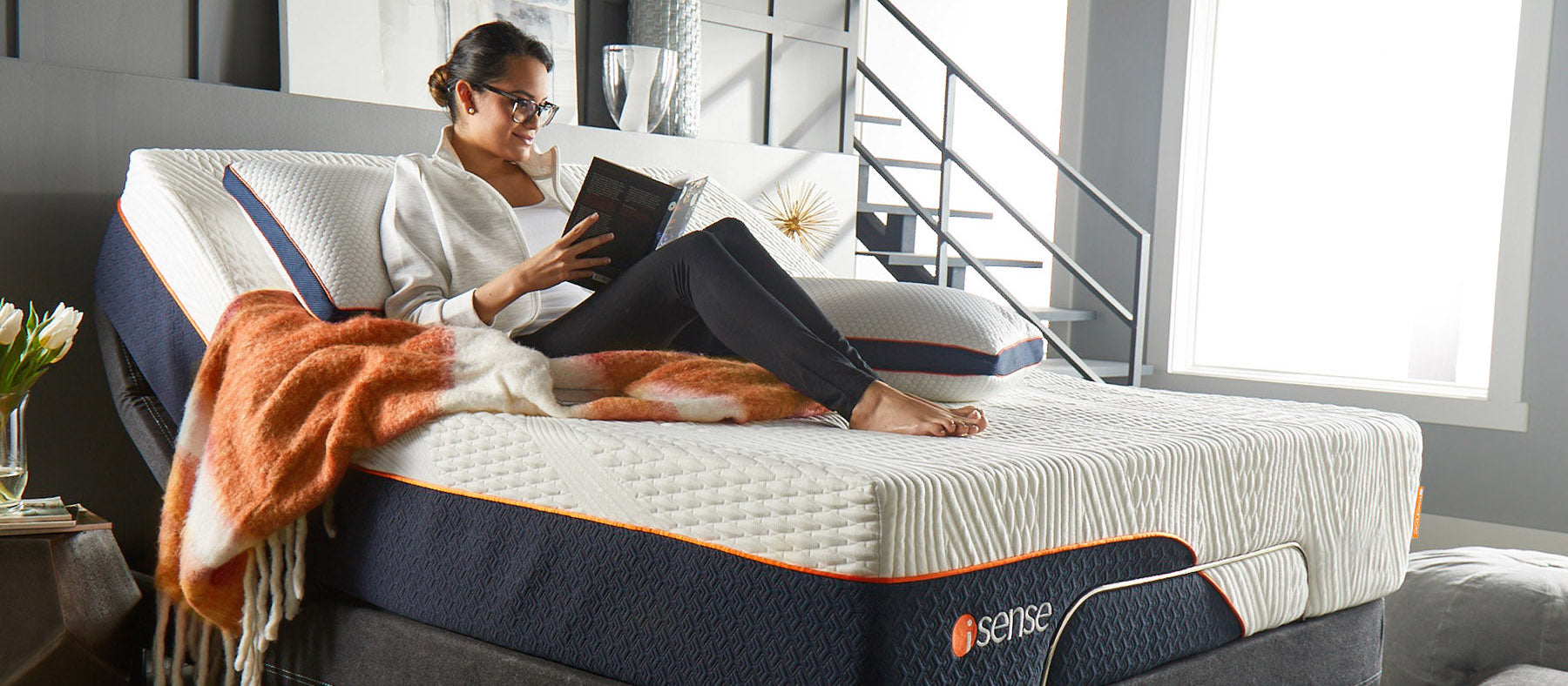If you've been struggling with persistent back pain, it may be time to consider rethinking your mattress. While there is no universal answer for every aching back, the quality and comfort of your mattress — as well as certain adjustments — can have a significant impact on the relief of your back pain. So, if you’ve been in a funk searching for a way to make your back happy, read on for some tips on how to adjust your mattress for back pain relief.
Quick Recap of Key Points
Adjust the firmness of your mattress and make sure it's properly supporting your body. You may also need to look into getting an adjustable base or specialty mattress designed to reduce back pain. iSense mattresses offer adjustable firmness with comfort at 20 settings as well as adjustable bases, so you can find your unique sleep environment.
Adjusting the Mattress Firmness
Adjusting the mattress firmness is an important factor when considering back pain relief. Each person’s needs will be different. Finding the right combination of support and comfort is key to finding back pain relief while sleeping. For example, some people may feel like a firmer mattress provides better support, whereas others might prefer a softer mattress.
Some mattresses offer adjustable firmness. iSense mattresses, for example, offer twenty adjustable comfort settings on each side of the bed. This customizable feature makes it easier for consumers to find what works best for their own personal sleep needs and preferences, especially when it comes to back pain. No matter the setting, iSense mattresses offer the same level of pressure relief from soft to firm.
There are commonly held ideas about what kind of mattress helps back pain the most—but it really depends upon the construction and quality of the mattress. And above all, it depends upon your unique sleep and comfort needs. Some say soft mattresses may provide superior pressure point relief and conformability for those who feel uncomfortable on a firmer bed. Firm mattresses can promote spinal alignment but may feel too hard on certain parts of the body, causing discomfort. In the end, it is pressure relief that is going to make the biggest difference. iSense mattresses offer the same level of pressure relief at every setting, whether the mattress is soft or firm. Choosing between soft or firm can be difficult but knowing how to adjust your mattress so that it meets your individual needs is key in achieving back pain relief while sleeping.
Now that you know how to adjust your mattress firmness for back pain relief, the next section will discuss important factors to consider when choosing a mattress.
How to Choose a Soft vs Firm Mattress
When selecting a mattress, many people choose between soft, medium and firm models. These descriptors are extremely subjective. Which option is right for you depends on a variety of factors including your body type, sleeping position, and individual comfort preferences.
Soft Mattresses: Soft mattresses involve layers of cushioning foam or pillow-top padding for added comfort. People who prefer softer surfaces may find that these mattresses are better for achieving sound sleep. However, to help alleviate back pain, a soft mattress must contain proper support.
Firm Mattresses: On the other hand, hard mattresses are traditionally thought to provide spinal support by creating a balanced surface that resists sinking too much in any one area. Consequently, firm mattresses could be ideal for some people who suffer from lower or upper back pain, as they reduce stress on pressure points. Nonetheless, some individuals may find firm mattresses uncomfortable, particularly if they prefer an extra layer of cushioning between themselves and the mattress surface.
Ultimately, selecting a mattress that is both comfortable and supportive requires experimentation and understanding the factors at play for you as an individual when it comes to back pain relief. Once you’ve decided between a soft or firm model, you can test it by taking advantage of an at-home mattress trial. Companies such as iSense and others that sell primarily online have risk-free trials so you can sleep on the mattress for a few weeks. This will give you enough time to adjust to the new feel and also determine whether it is the best support.
Highlights
When selecting a mattress, comfort and support should be taken into consideration. Experimentation and adjusting sleeping positions are necessary to find the right balance between comfort and support.
Adjusting Sleeping Position to Optimize Spinal Support
Optimizing your sleeping position for back pain relief can be a difficult task to tackle, as what works for one person may not work for another. And in addition, most people do move throughout the night into different positions, even if they typically start in one position. The best thing you can do to adjust your sleeping position in an effort to reduce pressure and support the spine is to pay close attention to body alignment in order to avoid any joint or muscle strain.
The most important part of achieving spinal support while sleeping is finding a comfortable but supported position. In general, you could begin with placing a pillow under the knees and lower legs when sleeping on your back, as this helps to take the pressure off of the lower spine. If you sleep on your side, try using a small pillow between the knees which puts less pressure on the hips and lower back. Stomach sleeping is not always advised, as it can put the most amount of strain on the neck, shoulders and lower back. However, if you do sleep on your stomach, be sure your mattress provides enough support to keep you from sinking in the middle.
When selecting a mattress, look at how much support it provides and how it keeps the spine in line with the neck and torso. Consider factors such as cushioning levels, density, responsiveness and cooling properties. It is also important to evaluate if you prefer one side over the other and if there are any hotspots that cause discomfort. If you feel a pressure point while lying on the mattress, it is an indication that it does not provide enough support. Mattresses such as those made by iSense offer pressure relief at all twenty settings.
Ultimately, the goal of optimizing sleeping position should be to ensure that different parts of the body are balanced throughout the night by working towards achieving proper spinal support whenever possible. However, it is often the case that people move throughout the night and you can’t always control every position. Additionally, getting enough quality sleep each night is essential for maintaining healthy energy levels and may help reduce overall pain experienced in the morning.
This section discussed adjusting sleeping position to optimize spinal support while addressing common concerns associated with back pain. In the next section we will look at evaluating your natural posture in order to further maximize comfort while reducing stress placed on different parts of your body during sleep.
- A study from 2013 found that changing the firmness of a mattress can reduce chronic lower back pain.
- In 2020, an extensive review published in Sleep Medicine Reviews concluded that medium-firm mattresses may be better for reducing chronic lower back pain. However, the challenge of a study like this is that “medium-firm” is highly subjective and hard to define.
- According to research from 2019, sleeping on a too-soft or very firm mattress can increase stress on joints and cause further discomfort while sleeping.
Evaluate Your Natural Posture
Evaluating your natural posture is an important step in adjusting your mattress for back pain relief. Many healthcare professionals recommend sleeping in a neutral or natural position that puts minimal stress on the spine. This natural position can be achieved by developing proper body mechanics, with most of the body’s weight and pressure evenly distributed. Doing so helps to avoid any sort of misalignment of the spine and reduces the risk of chronic back pain.
While there is some disagreement about what constitutes "natural" posture, generally speaking it should involve lying flat on one's back with legs straight, arms slightly bent at the sides, and a pillow under the head. Also, since many people prefer to sleep on their sides, experts suggest using a pillow wedged between the knees. This can help ensure proper alignment of both the low back and hip areas while avoiding any unnecessary twisting of the spine in those positions. Maintaining proper positioning mainly means avoiding twisting of the spine.
Though there are numerous benefits to achieving proper body mechanics and a natural posture during sleep, there are still those who argue that individual preferences should be taken into account. Some argue that preference-based sleep positions may provide more comfort than neutral positions, allowing for better rest and improved energy levels upon waking. Though this is true for some individuals, experts do caution that misalignment caused by improper body positioning could lead to health problems over time. The main issue to watch out for is twisting of the spine.
The evaluation of one's basic stance is therefore crucial when trying to adjust a mattress for back pain relief as it helps identify potential problems before they become too serious. Going forward, this will be an important factor in reducing discomfort and promoting healthy sleeping habits.
Modifying the Mattress With Mattress Toppers
Many think that adjusting the mattress with a mattress topper is an easy and affordable way to find back pain relief. However, if your mattress provides the right level of relief, you shouldn’t need to invest additional money into a mattress topper. The goal is to find a mattress that works for you without having to add additional measures for support. It can also alter the cooling properties of a mattress.
Alternatively, some experts recommend avoiding mattress toppers altogether as they may not be necessary for all types of beds. The main argument is that adding an extra layer may block the benefits of the mattress’s natural support system, which could cause more harm than good over time. It is important that any decision about using a mattress topper should be based on research, medical advice, personal preference and trial-and-error.
Ergonomic Solutions for Back Pain
The idea behind ergonomic solutions for back pain is to provide greater postural support and flexibility. This can include the use of adjustable bed frames, ergonomically designed mattresses and chairs, or posture-correcting devices that limit slouching and twisting. Adjustable bed frames allow you to choose a more comfortable sleeping position for your spine and shoulders. Ergonomically designed mattresses are constructed with different firmness, contour, and support layers to ensure proper alignment during sleep. Chairs that have adjustable backrests, armrests, and lumbar support will also help alleviate back pain by giving the spine better postural support throughout the day.
Posture-correcting devices such as braces or corrective braces limit your ability to twist or slouch, providing gentle guidance for healthy spine positioning throughout the day. Lastly, standing desks are an ergonomic solution that can help reduce back pain because they keep your body in a standing position, helping to prevent spinal misalignment and encouraging movement throughout the day.
There is debate over how effective these ergonomic solutions are in reducing back pain long-term. Some argue that while some of these products can create short-term relief, their effectiveness wears off after prolonged use or due to improper usage. Others maintain that when used correctly, these solutions can offer lasting relief from chronic back pain.
Achieving Optimum Comfort for Back Pain
Getting a good night’s rest is essential in managing back pain, and the mattress can play an important role. Many people who suffer from chronic back pain often find that they need to adjust their mattress to achieve optimum comfort and minimal pain. It is essential to find the right balance between firmness, softness, and contour and what works best for your specific condition.
Firmness: A too-soft or too-firm mattress can contribute to back pain. Or a mattress that sinks, sags or dips from poor construction or wear and tear. It’s important to find a mattress with the right amount of pressure relief for solid support. For some people, a firmer mattress may provide more support, while others may benefit from something a bit softer. It may take some trial and error to find the perfect balance and it will vary from person to person.
Softness: Soft mattresses can be just as supportive as a firm mattress, if the construction of the mattress is built for pressure relief. Too much softness without support can create pressure points that aggravate back pain so it’s important to find the perfect balance between support and softness.
Contour: Different people require different levels of contouring when it comes to their mattresses and how they affect their particular type of back pain. Some people respond better to mattresses that provide extra contouring around their hips and lower back while others prefer softer sweeter spots in those areas. Mattress companies offer models with adjustable layers that accommodate different support requirements so there is likely one available that fits your individual needs.
To achieve optimum comfort for your back pain, it is important to prioritize finding a mattress that offers just the right balance of firmness, softness, contouring—something that works best for your specific condition. Unfortunately, what may work well for one person may not work well for another; thus, it is important to understand your unique needs and make adjustments as needed until you find the perfect fit for you.
Answers to Frequently Asked Questions
What types of adjustments should I make on my mattress for back pain relief?
The type of adjustment you make to your mattress for back pain relief depends on the cause and severity of your back pain. Generally, if your back pain is caused by poor support from your mattress, then you will want to consider a mattress that offers adjustable firmness and pressure-relieving support, like an iSense mattress. For mild to moderate aches and pains resulting from poor posture or an injury, adding padding or a supportive pillow top to your mattress might help. This could be a temporary measure to supplement the support of your mattress. You could also consider exchanging your traditional innerspring mattress for one made with memory foam or latex; these types of mattresses are much more supportive and provide better pressure point relief. Additionally, some mattresses, such as those made by iSense, come with adjustable firmness settings so you can tailor the level of support to suit your needs. If you’re unsure which adjustments will work best for you, it’s always best to consult with a doctor or certified orthopedic specialist first before making any changes.
What are some of the potential benefits of adjusting my mattress for back pain?
The potential benefits of adjusting your mattress for back pain relief can be significant. First, it can help reduce or eliminate the discomfort associated with existing back pain. By supporting your body in the correct alignment and taking pressure off of specific areas, an adjustable mattress can offer relief from aching muscles, joints, and ligaments.
Second, an adjustable mattress may also be beneficial in preventing future episodes of back pain by providing optimal support to your spine as you sleep. Proper spine alignment can help reduce stiffness and improve circulation, which can lead to better overall sleep quality.
Finally, an adjustable mattress can offer a more customized experience that is tailored to your individual needs. With options such as head elevation, lumbar support, massage features, and other comfort settings, you can find the perfect setup to give yourself maximum comfort and back pain relief while you rest.
Are there any special techniques I need to use when adjusting my mattress for back pain?
Yes, there are several special techniques you can use when adjusting your mattress for back pain relief.
First, make sure that the support provided by your mattress is appropriate for your body type and sleeping position. For example, a side-sleeper might require a softer mattress than a stomach sleeper would. It's important to get the right level of support in order to avoid putting extra pressure on certain parts of your body, like your hips and shoulders.
Second, adjust the firmness of your mattress so that it conforms to your body's contours and alleviates sore spots. Some mattresses like those made by iSense come with adjustable firmness levels, allowing you to customize the level of comfort and support depending on your needs.






















